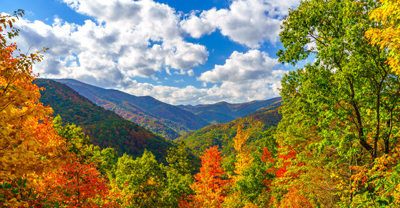Going-to-the-Sun Road: A legendary ride through Glacier National Park


0 min. read
Heart-pounding curves, endless mountain majesty, and storied landmarks—that's the appeal of Glacier National Park's Going-to-the-Sun Road winding through northwestern Montana. Feel the sun warm your leathers as you carve legendary switchbacks, each bend revealing a vista more epic than the last. This isn’t just a scenic drive, it's a motorcycle pilgrimage named after the Blackfeet legend of the sun god's daily journey. Ready to trade the ordinary for extraordinary? Try this ride.
Planning your Going-to-the-Sun Road trip
Completed in 1933 after two decades of engineering marvel—Going-to-the-Sun Road features miles of exhilarating hairpin turns, switchbacks, and elevation changes. This legendary road has earned the status as a National Historic Landmark in Montana and one of the most scenic drives in the United States.
Spanning 50 miles through the heart of Glacier National Park, the trans-mountain highway offers exceptional views and crosses the Continental Divide. Expect a two-hour ride, not including stops for capturing breathtaking photos or exploring hiking trails.
Access to the road requires admission to Glacier National Park, priced at $30 per motorcycle.
Going-to-the-Sun Road route map
Offering a safe ride with proper edge barriers, Going-to-the-Sun Road ascends to a breathtaking 6,466 feet at Logan Pass. While both directions offer stunning views, heading west to east allows for easier stops at overlooks. Opting to enter at St. Mary and driving westbound keeps you closer to the rock walls for added peace of mind.
Review the route basics—along with several must-see stops—in this interactive map.
Weather along Going-to-the-Sun Road
Be aware of weather conditions and seasonal closures before embarking on your trip. While the Going-to-the-Sun Road is typically open between early July and mid-October, snowfall and plowing can affect the exact dates. Check the National Park Service website for current road conditions.
This monthly weather data for Glacier National Park can also help you plan.

Get a cost-free motorcycle insurance quote today.
Motorcycle safety tips for Going-to-the-Sun Road
As you wind through the majestic curves of your glacier-carved ride, keep these essential safety tips in mind:
Gear up. Make sure you're equipped with the right gear—from a DOT-approved helmet to sturdy footwear and gloves. Given this route’s unpredictable weather and elevation changes, dress in layers and carry rain gear and cold-weather clothing.
Focus on the road. Prepare yourself for tricky road conditions with narrow lanes, sharp curves, and steep inclines. Watch out for falling rocks and expect road work, workers, and delays due to the short summer season.
Don’t rush it. Speed limits range from 25 to 45 mph, so plan your route accordingly and adjust your pace to match the curves of the road. Take special care on hairpin turns and switchbacks by easing off the throttle to maintain control.
Plan your stops. Schedule breaks to rest, hydrate, and take in the stunning scenery. Use designated pull-offs and overlooks for safe photo opportunities and to help prevent fatigue.
Watch for wildlife. Make sure to follow park rules, like sticking to speed limits and respecting wildlife. Stay alert for animals like mountain goats and bighorn sheep crossing the road, giving them space to pass safely.
Use caution at Logan Pass. Be extra careful when crossing Logan Pass, the road's highest point. Watch for traffic jams, pedestrians, and changing weather conditions. Yield to oncoming vehicles in tight spots.
Where to stop along Going-to-the-Sun Road
Embrace the adventure, but be prepared. Glacier National Park offers limited food and no gas options. Top off your tank before entering and pack plenty of water and snacks to avoid any hiccups. Trust us, the breathtaking scenery will make any minor inconveniences quickly fade away. Here are some highlights:
Lake McDonald
Start your adventure at Lake McDonald, the largest lake in the park. Carved by glaciers, it reaches depths of nearly 500 feet, with crystal clear water and a colorful rock-lined bottom. Several small beaches dot its 10-mile shoreline, so pack your swimsuit and towel and consider taking a dip in the cool, invigorating waters.
The Weeping Wall
The Weeping Wall is easily accessible as you drive along the road, offering a perfect spot to stretch and enjoy the scenery without adding much to your travel time. This stunning waterfall cascades down a 100-foot rock face directly onto the roadside, creating a refreshing mist and a display of nature's power, especially during peak snowmelt in early summer.
Big Bend
Big Bend is one of the best areas on your ride to catch the sunset. As its name implies, Big Bend is where Going-to-the-Sun Road bends back on itself, creating a U-shape. This large pull-off provides a panoramic view of glacier peaks, including Mount Oberlin, Mount Cannon, and Heavens Peak.
Logan Pass
You’ll stand at nearly 6,500 feet at Logan Pass—and straddle the Continental Divide. This area is full of alpine meadows, wildflowers, and wildlife sighting opportunities. Stop in the Logan Pass Visitor Center to chat with park rangers and shop for souvenirs. You’ll also find the park’s most popular trails: the Highline Trail and Hidden Lake Trail.
Jackson Glacier Overlook
Jackson Glacier is the seventh-largest glacier in the park—and it’s the only glacier you can see from Going-to-the-Sun Road. Bring binoculars to see its full glory. If you have time, hike toward it along the trail to Gunsight Lake.
Wild Goose Island Overlook
You’ll reach Wild Goose Island Overlook as you continue toward St. Mary. This west-facing spot provides majestic sunrise and sunset views as the light reflects off the water. If you're a fan of The Shining (1980), you might recognize the breathtaking view—it's the same one featured in the film's opening credits.

Get your free motorcycle insurance quote today.
La información general contenida en este blog tiene únicamente fines informativos o de entretenimiento. Vea el descargo de responsabilidad de nuestro blog.
*La exactitud de los datos está sujeta a la fecha de publicación de este artículo.










